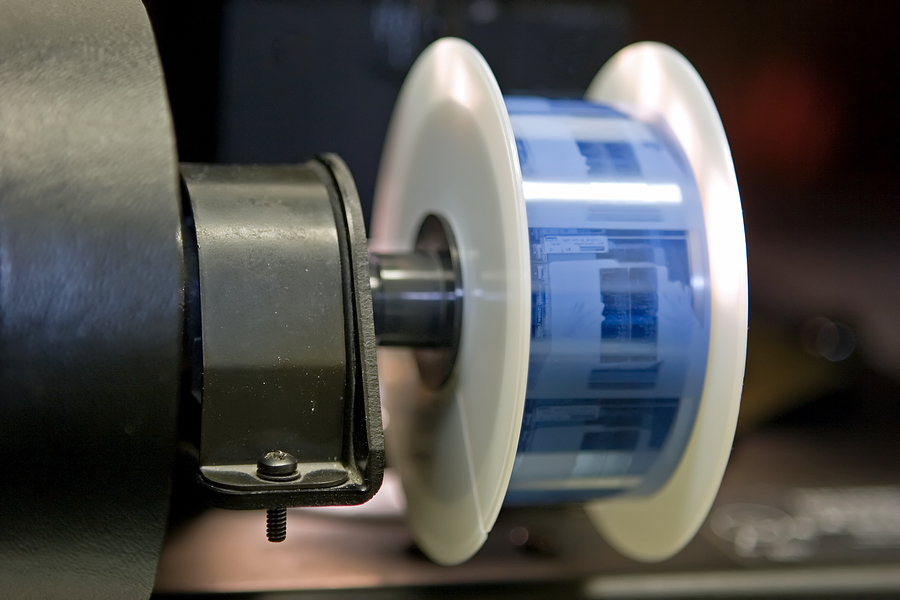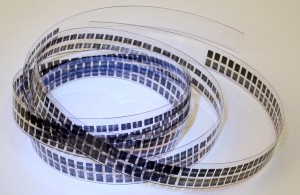
Paper documents are vulnerable to deterioration over time if mistreated or stored improperly. Most papers these days contain natural impurities and byproducts of the manufacturing process that cause the paper to break down in the presence of heat, light, and moisture in the air. These pollutants can cause issues for storage spaces and lead to embrittled and discolored documents.
 If you have your hands on microfilms or microfiches, they are some of the best storage mediums to combat these effects. These films, or cards, can hold large amounts of information in a smaller capacity and can be an effective storage solution that takes up less space than paper records. They provide a long-term solution for your data, and as long as the documents are properly maintained, these physical files still pose a risk of damage over time if they aren’t properly stored.
If you have your hands on microfilms or microfiches, they are some of the best storage mediums to combat these effects. These films, or cards, can hold large amounts of information in a smaller capacity and can be an effective storage solution that takes up less space than paper records. They provide a long-term solution for your data, and as long as the documents are properly maintained, these physical files still pose a risk of damage over time if they aren’t properly stored.
What Kind of Microfilm Do You Have?
The term microfilm is a catch-all phrase for all formats of this type that record media. Unless you work within the scanning industry or as a records manager, microfilms may all appear the same, but you can have many different types of microfilms.
Microfilms
Microfilms are roll films that contain a sequential series of images and frames. These types of storage documents are often used for various types of documents, and each size of roll film can determine the specific purpose of what records are held. For instance, most 16mm roll films are used for office-sized documents, such as building permits, financial records, and other official documents. They are usually found in government offices, credit unions, and insurance companies. However, 35mm microfilms tend to hold larger, oversized documents such as deed books and newspapers and are used to hold information that 16mm roll films cannot.
Microfiche
Microfiche, from the French word “small card,” is made of a flat sheet of film with a polyester base. Multiple pages are captured on these cards at a reduced size, with the standard size being about 4 x 6 inches. The images of the documents are contained in rows and columns, and the cards can hold anything from NDA contracts to cashier’s checks.
Aperture Cards
Lastly, aperture cards are similar to IBM punch cards, containing a hole (aperture) where a single 35mm microfilm frame can be mounted. The machines used to punch the holes in these cards were considered the metadata of the documents associated with the microfilm image and used for visual identification. These cards are most often seen in engineering applications and are considered a rarer kind of microfilm these days.
No matter the type you have, if you choose to convert paper documents to microfilm, then it’s recommended by experts to use polyester-based film instead of cellulose film if you need the records to last longer.
How to Store Your Microfilm
If you’re working to store your microfilm, it’s important to know their differences so that the film images can retain their integrity over time. The easiest way to store microfilm is with an off-site storage facility, which can keep your roll films safe and save time and money. However, if you intend on storing your microfilms on-site, here’s what you should know about how to store your microfilm:
 Pack It Tightly: Pack your microfilm tightly to prevent oxidation. Exposure to moisture in the air is one of the main causes of degradation over time, so pack these documents individually in boxes or envelopes to protect them.
Pack It Tightly: Pack your microfilm tightly to prevent oxidation. Exposure to moisture in the air is one of the main causes of degradation over time, so pack these documents individually in boxes or envelopes to protect them.
Temperature-Controlled Environment: When storing the microfilm, store them in a temperature-controlled environment. The temperature within the room should not exceed 70F. For moisture and humidity, the humidity of the environment should be below 50% to prevent the onset of condensation and heat damage to the microfilms.
Keep Your Storage Dark: Your storage rooms should be absent of light, as light contains microparticles that can gradually damage the roll films.
Avoid Wooden Cabinets: Wooden cabinets tend to hold onto acids and other substances, and when in contact with the microfilm, can damage it over time. It’s best to use closed steel cabinets for microfilm storage, as they can prevent abrasion and emulsion over time.
Wear Gloves: When handling the microfilm, wear gloves. Gloves prevent oil residue from transferring from your hands to the film itself. Handle the film carefully to prevent damage, especially if you intend on keeping these devices safe for a long time.
Use Acid-Detection Strips: Placing acid detection strips can help catch increases in acetic acid. Acetic acid increases the deterioration of these films and causes a vinegar odor to appear, and these detection strips can help keep your storage units clean and orderly.
Warm Up Before Storing: Allowing the film to gradually warm up before handling it can prevent moisture from damaging the film. Usually, after this process, you must wait a few days before looking at a requested film.
Quarantine and Remove: If the film shows any sign of degradation, it’s essential to remove all microfilms from the storage room and separate the affected film to prevent other devices from contracting the problem. You can then work to resolve any issues within your storage unit.
Well-stored microfilms can have a shelf life of over 500 years when cared for properly, but these documents require much work to prevent the onset of microfilm deterioration.
What Signs To Look For With Microfilm Deterioration
Microfilm deterioration is considered one of the biggest problems for those wishing to store and preserve their microfilm documents. When these documents contain sensitive or personal information, storing them in a stable environment that is as cold and dry as possible should be used to protect your materials from decay and damage. But if you are facing deterioration issues, it’s important to know what’s causing it.
 Microfilm Smells Like Vinegar
Microfilm Smells Like Vinegar
This occurs when the acetate chemicals in the film break down over time and turn into acetic acid. This acid is also present in vinegar and gives off a distinct aroma. Any acetate-based microfilms are subject to this deterioration and can spread to other films once they start. Make sure to create duplicate copies on polyester-based films, which are immune to this issue, and, eventually, convert them to a digital archive to protect them further.
Microfilm with Orange Spots
Also known as redox, the local oxidation of silver creates the formation of red, orange, and yellow spots on the microfilm. This is caused by exposure to air, moisture, and contaminants. If your films have redox, then it’s important to staunch the progress with a brown toner. This chemical treatment changes the processed silver to silver sulfide, making it more resistant to humidity and oxidants and protecting it against further corrosion.
Flaking and Falling Apart
This refers to embrittlement or the loss of elasticity in plastic film over time. It’s an aging process where the film cannot withstand bending and twisting under strain. Under exposure to heat, moisture, and acids, this process quickens and causes the polymer chains to break loose. This process is irreversible, but in its early stages, it can be temporarily treated with solvents that soften the film so it can be duplicated.
 Can Microfilm Backups Be Converted Digitally?
Can Microfilm Backups Be Converted Digitally?
Yes, and it’s often encouraged to convert microfilm to digital formats, either as a backup or as a complete replacement for the microfilm. Digitization is considered an excellent way to have a backup copy of your content in disasters, such as faulty storage rooms, stolen films, and other concerns, because every time you handle these films, the film becomes exposed to conditions that can damage it. When converted to a digital format, employees and others who need to reference the documents can do so through a digital database.
Upgrade Your Document Management Today with Record Nations
When it comes to upgrading your storage methods, Record Nations can help. Our expert team provides microfilm conversion services that can be used to help you have easy access to your documents whenever you need them most. At Record Nations, we collaborate with experienced professionals nationwide to deliver the exact solutions your company needs. To start improving your records management and backup systems, fill out our online form, use our live chat, or call us at (866) 385-3706 for your records management needs.









